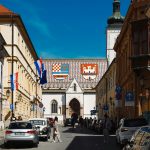As Poslovni Dnevnik/Marija Crnjak writes on the 7th of July, 2019, the director of Cushman & Wakefield CBS International for Croatia, a global real estate market player who entered Croatia’s market back in May, explains why the domestic property market has been more lively over the last few years and to what extent developers have taken advantage of that positive trend.
He also revealed his recommendations that Croatia can follow to make sure everything improves, how it can use this new investment potential to the maximum extent possible, and discussed the situation in Croatia’s region.
Cushman & Wakefield has expanded its exclusive cooperation with CBS International with its entrance onto the Croatian market back in early May, promising new projects and investors that have continued to show a growing interest in investment in Zagreb, along the Adriatic, and even in other parts of the country.
Cushman & Wakefield already covers the regional markets of Serbia, Macedonia and Montenegro, with a total of 51,000 employees in more than seventy countries, it is among the largest companies specialising in commercial real estate services and enjoys a massive 8.2 billion dollars in revenue. Poslovni Dnevnik sat down and talked with Predrag Tutić, the director of Cushman & Wakefield CBS International for Croatia, and talked about the new investment cycle that is expected in Croatia, the investment projects with the greatest potential, property prices and the legal regulation in the property valuation segment.
Why are you just entering the Croatian market now?
The company’s global strategy is to be present on the markets where the customers are present. So far, it’s been organised so that markets are covered by regional centres from the surrounding countries. Thus, Budapest was responsible for this part of Europe, and the Prague office supervised operations throughout Southeastern Europe. It has been shown that we’ve not been able to provide enough strong local support to our customers because there is a need for local knowledge as the market is sensitive and investors are very precise in seeking information.
The markets are similar, but we can already see the difference between the Zagreb market and that of Belgrade or Budapest, not to mention the Czech Republic or Slovakia, which are markets that are much more active.
Our clients are banks and investment funds that require consulting or property assessment services, then companies which go on and open new offices and domestic or foreign developers who’re developing projects on the housing market or the commercial real estate market.
Is your entry onto this market an indicator of stronger dynamics on the Croatian real estate market?
Of course, the market has come to life in the last three years and is dynamic. Zagreb recorded a slight increase in transactions in all segments on the property market and this trend will continue, so the city will remain attractive for investments, as will Croatia’s coastline which is always attractive for tourism investments.
The main reasons for the revival of the real estate market in Zagreb can certainly be seen in the recovery of the economy with a low level of unemployment and a rise in salaries and personal consumption. In addition, banks are very liquid and lending is convenient.
All this has resulted in higher demand for all products on the property market, we know that most shopping malls have changed owners, and there were great investments that took place in tourism as well. The housing market has already been very dynamic for three to four years now, there are a growing number of transactions, new projects are well thought-up and respond to the needs of the market, so investors didn’t encounter any problems with their sales.
What can you expect in the future, what do you count on?
In the forthcoming period, we expect a new investment cycle that will bring in modern projects with new content, but to do so, we have to work on the development of infrastructure and urbanism, in the City of Zagreb and in other cities in Croatia. City zones need to be defined in a better way and locations for new types of projects that will provide a different type of experience with their concept and content, either in offices or in the residential segment, need to be prepared. Market changes happen very quickly, business models are changing and investors have to follow that. In the surrounding countries, such projects have existed for years and Croatia is now prepared for them.
In Zagreb there’s a low rate of free office space, and so the prices are stagnating.
The vacancy rate is now below five percent, which clearly shows that the market is ready for new projects. We expect the lease prices to remain stable, but future projects that will be defined by the new standards will also have some higher prices. So far, the generators of the growth of the property market have been IT companies which grow quickly, they have been among the first to have implemented new standards in using their business premises to motivate and retain their employees in a stimulating working atmosphere.
Have you noticed the greater interest of foreign investors in Croatia?
There’s definitely great interest from foreign investors, as well as from domestic investors and developers who have been analysing Croatia’s market for some time and considering all the possibilities for investing in Croatia.
So far, there have been some attempts made by investors but now is definitely the right moment to catch that wave. It’s necessary to define projects and investment zones where they can realise their ideas. We support them in every step, from the project definition itself, its features, the preparation of the market project, the analysis of the site itself with the investor, participation and monitoring of different stages of project development, and finally at the point of placing the investment onto the market.
How do markets differ in Zagreb and Belgrade?
Zagreb’s investment cycle and market development began in all segments ten years before Belgrade’s did, which is particularly noticeable in the segment of commercial real estate. In 2009, Zagreb had one million square metres of office space, and Belgrade will only reach that number by the end of 2020. In the retail space segment, Zagreb has 650 square metres of space per 1,000 inhabitants, and Belgrade on the other hand has 230 square metres. However, Belgrade is a bigger city and there is a greater need for new commercial spaces, which is one of the reasons for the current expansion of the market.
How big is the market in Budapest, and the Czech and Slovak markets are saturated, what’s happening there?
These are bigger and more developed markets, but more importantly – the quality of the offer they have differs significantly when compared to that which Croatia offers and have long been on the map of institutional funds. On the other hand, it’s difficult to talk about the same trend for all segments of the market as they go through different phases, because they’re heavily dependent on supply and demand. For this reason, in such countries, investing in better quality commercial or residential projects that will respond to specific market niches as well as investing in alternative investments such as investment in student homes or homes for the elderly, are increasingly present.
Will house prices rise further?
Over the last three years, prices in Zagreb have risen, which is the result of new projects that have been better defined and as such introduced new prices. When we talk about housing construction, we have to make a difference between demanded and realised prices. I’d say that the realised housing prices in the coming period will not grow drastically, because we’re still a market with limited capacities. We’ve had a very similar number of transactions in the last three years, so we don’t expect any bigger deviations here.
Do you see a place for the development of long-term rental projects?
Certainly, this is a model that happens abroad, and it will certainly be one of the segments that will start to develop here, whether it’s generally intended for housing or for student accommodation.
The long-term rental market is slowly stabilising. It is well known that a large number of owners have changed things up with their property to suit short-term rentals on the tourist market, but I think we’ve reached a certain maximum on this issue and the trend is that the owners of apartments will slowly return to long-term rental market. Tourism management requires serious engagement, property preparation, and constant investment to make the market competitive and generate revenue. I expect the market to stabilise over the next two years, and I also expect new investors for long-term leases.
Make sure to follow our dedicated business page for more information on investment in Croatia, the real estate market in Croatia, doing business in Croatia and much more.








